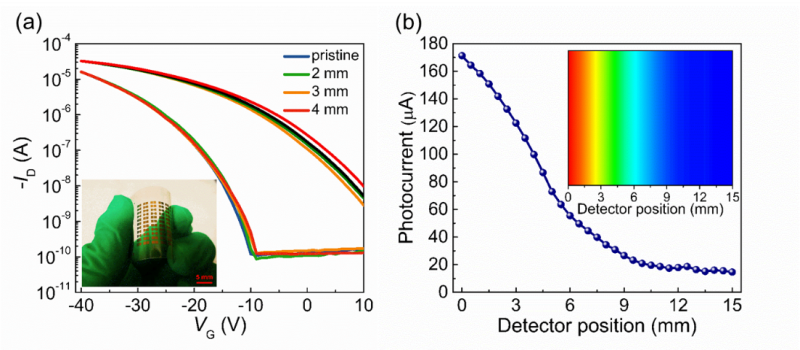Scientists Develop Ultrasensitive Organic Phototransistors Based on Novel Hybrid-Layered Architecture
Date:13-05-2019 | 【Print】 【close】
Prof.LI Jia and GAO Yuanhong, from Shenzhen Institutes of Advanced Technology (SIAT) of the Chinese Academy of Sciences, in collaboration with Prof. WANG Xinwei, from Peking University Shenzhen Graduate School (PKUSZ), developed a novel hybrid-layered architecture to improve the overall photodetection performance of organic phototransistor by simultaneously taking advantages of charge-trapping effect and efficient carrier transport.
The relevant research entitled “A Novel Hybrid-Layered Organic Phototransistor Enables Efficient Intermolecular Charge Transfer and Carrier Transport for Ultrasensitive Photodetection" was published in Advanced Materials.
Organic phototransistors (OPTs) promise a variety of industrial and scientific applications, such as environmental/health monitoring, quantum communication, chemical/biomedical sensing, remote control, surveillance and image sensors, with the merits of low-cost, light-weight, high efficiency and good environmental friendliness.
The interfacial charge effect is very crucial for high-sensitivity OPTs. The conventional layered and hybrid OPTs suffer from the trade-off in well balancing the separation, transport, and recombination of photogenerated charges.
The researchers from SIAT and PKUSZ proposed a novel hybrid-layered phototransistor (HL-OPT) which has overcome these hurdles and achieved the high-performance photodetection. The structure consists of a high mobility organic semiconductor channel layer for fast carrier transport, an organic bulk heterojunction (BHJ) photoactive layer, and an ultrathin inorganic interlayer sandwiched in between.
Excitons generated in the photoactive layer, dissociated into electrons and holes at the donor/acceptor BHJ. The generated electrons are readily trapped by the acceptors nearby and holes are injected into the channel layer to increase the carrier concentration. An inorganic interlayer is chosen to further enhance hole injection and block electrons, subsequently suppressing electron-hole recombination. As a result, by combining the virtues of charge-trapping effect and fast carrier transport, significant enhancement in the overall photodetection performance is achieved from the HL-OPT.
To evaluate the potential applications of the high-performance HL-OPT, the research team fabricated the devices on flexible substrates and confirmed their excellent flexibility. Meanwhile, the devices are also integrated into a one-dimensional array and demonstrate the reliability of the HL-OPT in photosensitive imaging system. “These successful trials make the HL-OPT particularly appealing for the applications in flexible and wearable optoelectronic devices.” said Prof. Li.
This work provided new insights into the design and optimization of the high-performance photodetectors, spanning the ultraviolet and near infrared range, as well as suggested the fundamental issues pertaining to the electronic and photonic properties of the devices. “Another exciting point is that this organic photodetector can be potentially fabricated by using printing techniques, which would further reduce the process cost,” said Prof. Li. “I hope this work can provide the market with a promising solution for photodetectors by combining both high performance and low cost.”

Fig1. The structure of hybrid-layered phototransistor (Image by Prof. LI Jia)

Fig2. Ultrasensitive organic phototransistors based on novel Hybrid-Layered Architecture (Image by Prof. LI Jia)
CONTACT:
ZHANG Xiaomin
Email: xm.zhang@siat.ac.cn
Tel: 86-755-86585299